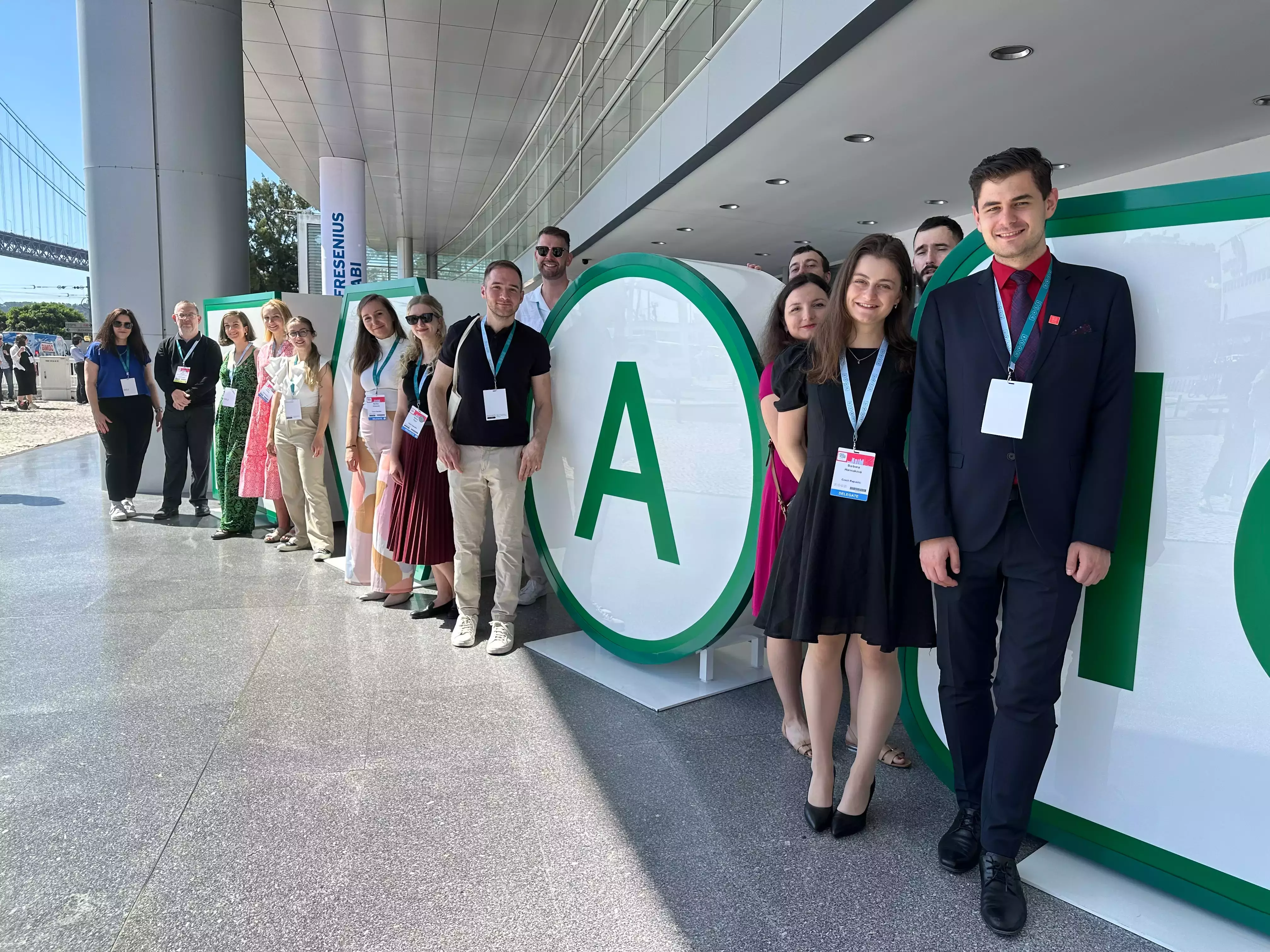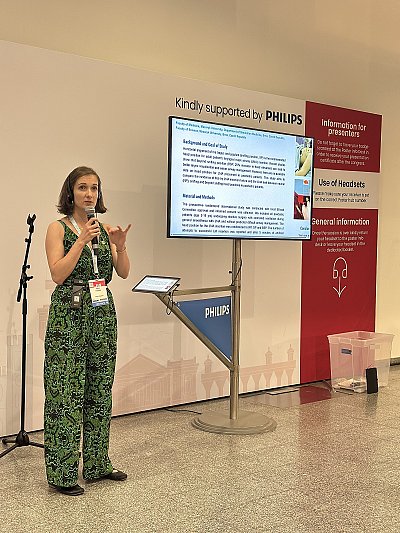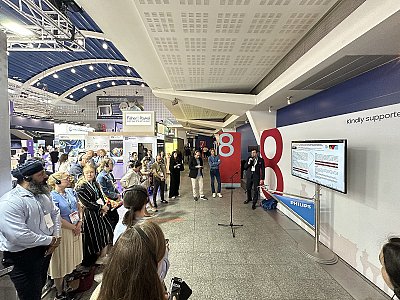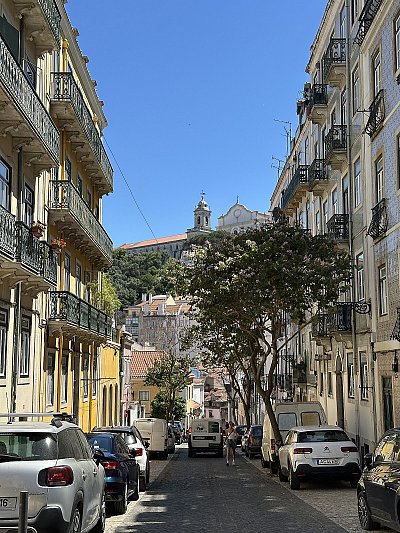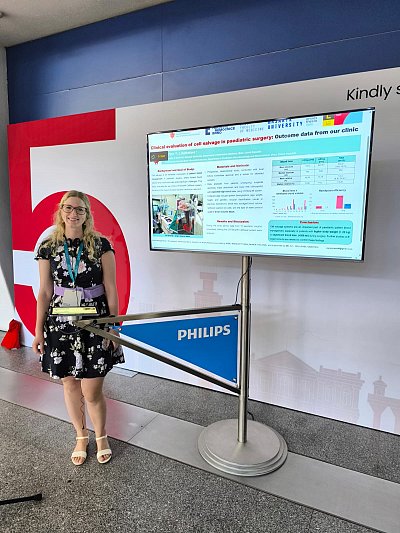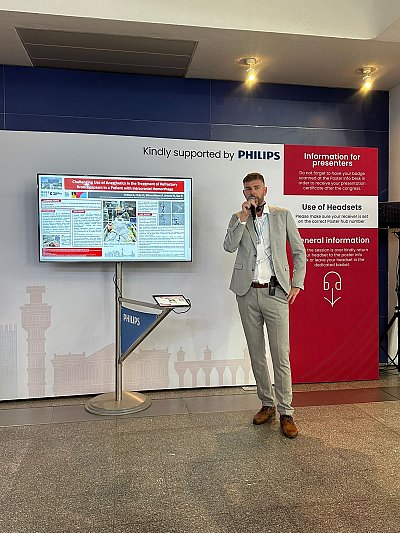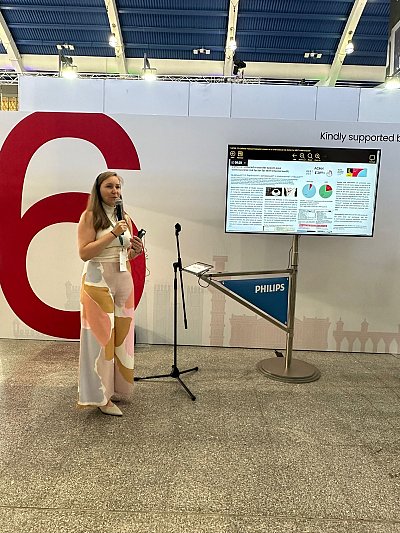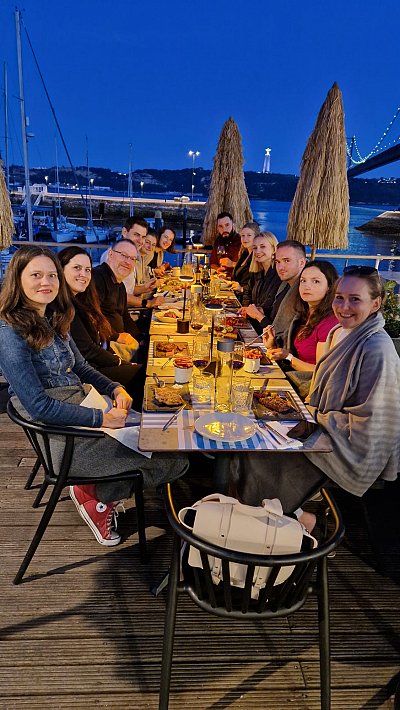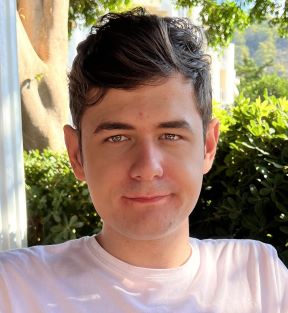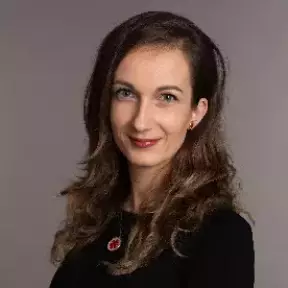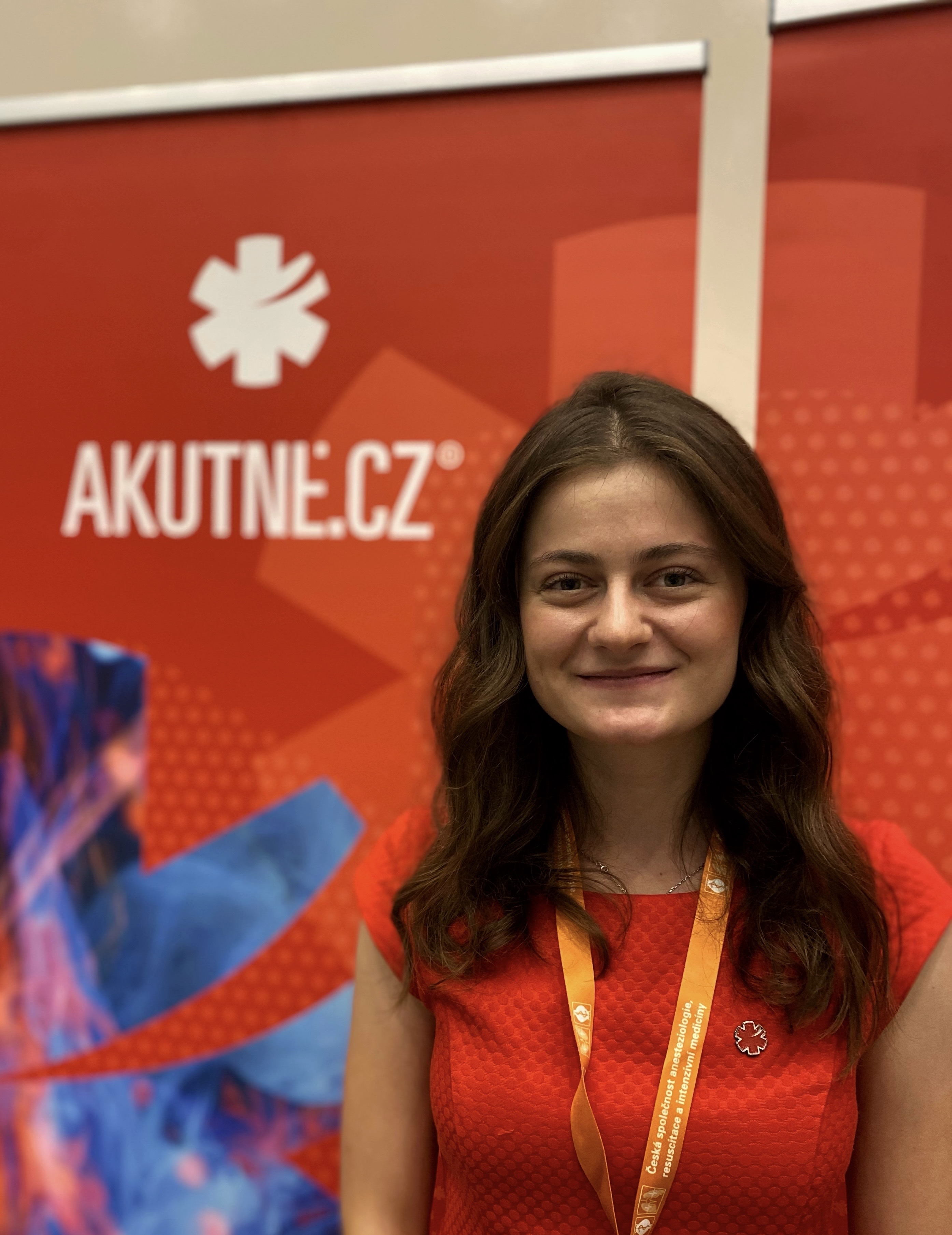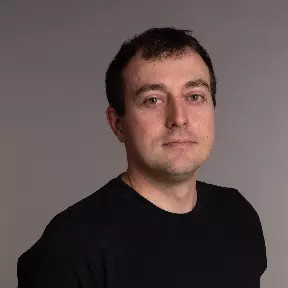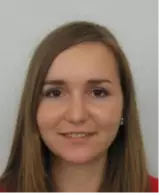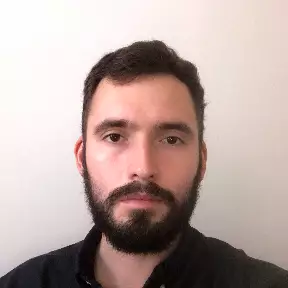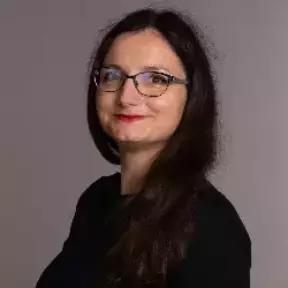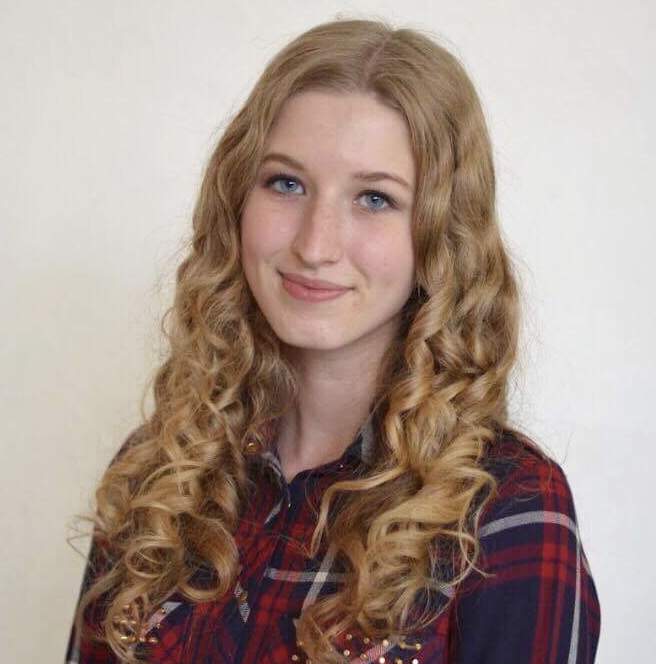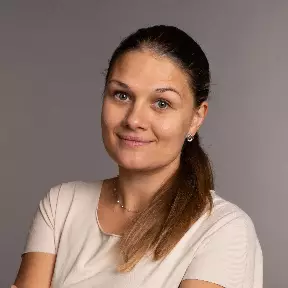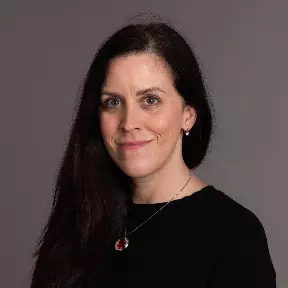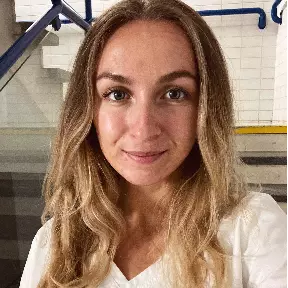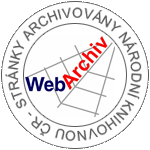Daniel Diabelko, KDAR FN Brno
As part of the ESAIC trainee session, Dr. Yotam from Israel gave an inspiring lecture on "Exploring Research: the Why and How of Academic Engagement." He emphasized that research is not just about more work but about changing one's mindset, which stems from curiosity and asking questions: why does one patient respond differently than another? Such questions lead to the creation of hypotheses, data collection, and, ultimately, studies that can influence everyday practice. He underscored the importance of small, incremental beginnings, such as data collection and the need for a quality mentor to guide us and enable us to grow. Over time, we can then become mentors ourselves and pass on our experiences.
In the State of the Art – Pediatric Anaesthesia section, Dr Infanger (Austria) gave a lecture on the caudal block as the only form of anaesthesia below the navel. This technique, often performed with only light sedation, is particularly suitable for children under 6 years of age. He described both the approach using anatomical landmarks and the use of ultrasound – ideally, a combination of both. He also discussed the dosage of local anaesthetics according to the required level of block and specific technical details of the procedure.
Dr. Brita von Ungern-Sternberg (Australia) focused on new developments in laryngoscopy in newborns and infants. She emphasized the importance of preliminary identification of whether the intubation will be routine or complicated, as well as the need for a prepared plan and communication with other staff. She presented studies comparing direct and video laryngoscopy, with video laryngoscopy clearly emerging as more advantageous in terms of success and complications. She also mentioned the benefits of HFNO (high-flow nasal oxygen) during intubation.
Dr. Vutskits (Switzerland) focused on monitoring pediatric patients. He reiterated the basic monitoring standards during anaesthesia and expanded them to include more advanced techniques that better reflect the patient's condition. He focused on the need to monitor tissue perfusion and oxygenation. He presented non-invasive cardiac output measurement and NIRS for monitoring oxy/deoxyhemoglobin in brain tissue. This monitoring gives us a much more detailed insight into hemodynamics than simple, non-invasive blood pressure monitoring. Finally, he presented EEG monitoring to assess the depth of anesthesia, seizures, or burst suppression patterns.
Barbora Horniaková, LF MU Brno
The block "Hot Topics in Critical Emergency Care – Last 12 Months' Top Publications" was opened by Dr. Povoa (Lisbon), who also introduced the main speaker of this section, Dr. Biasucci (Rome). He began his lecture with an overview of different types of studies and an explanation of the basic principles of systematic reviews and meta-analyses, emphasising the pitfalls of finding quality evidence in the field of intensive care medicine.
One of the important concepts he explained was the fragility index – an indicator that expresses how few changes in the number of events (e.g., a shift from "event" to "non-event") would be enough to make a statistically significant study result no longer significant. This serves as a tool for assessing the robustness of evidence in studies.
In the next part of the lecture, Dr. Biasucci focused on studies comparing intravenous (IV) and intraosseous (IO) access during resuscitation. The results showed that the key factor is not the route of administration itself but the speed of achieving vascular access and the onset of drug action. The studies found no significant differences in survival between IV and IO access, but IV access remains the preferred option if it is readily available.
The next part of the lecture dealt with the differences between extracorporeal cardiopulmonary resuscitation (ECPR) and standard CPR. New studies show that ECPR can lead to better long-term neurological outcomes, especially in selected patients (e.g., younger patients, short time without circulation). One meta-analysis reported that the use of ECPR in suitable candidates led to an approximately 5% increase in survival in up to 72% of patients, although the evidence is still inconclusive, and the method remains controversial due to its complexity and patient selection.
The physician also discussed hypothermia after cardiac arrest, specifically comparing surface cooling with intravascular cooling systems. The data showed that intravascular cooling achieves faster induction of the target temperature and may be more effective, although the differences in long-term outcomes are not entirely conclusive. Some studies recommend the intravascular approach in centers where it is available, mainly because of better temperature control.
New findings regarding oxygenation strategies in trauma patients were also presented. A comparison of liberal vs. restrictive approaches to oxygen therapy has not yet shown a significant difference in mortality, but the potential risks of hyperoxia, including oxidative stress, have been highlighted. Current recommendations, therefore, favour targeted oxygenation rather than routine high doses of oxygen.
Regarding transfusion thresholds in patients with traumatic brain injury (TBI), the speaker presented a comparison of liberal strategy (Hb 10 g/dL) vs. restrictive strategy (Hb 7 g/dL). The results showed no difference in mortality, but liberal transfusion may improve neurological outcomes, especially in the acute phase of injury. Emphasis was placed on individualizing the transfusion strategy according to the patient's clinical condition.
Another interesting part of the presentation was the newer studies on preoxygenation of children before intubation. It has been shown that the use of NIV (non-invasive ventilation) or HFNO (high-flow oxygen) led to less frequent episodes of hypoxia compared to a conventional oxygen mask. Both methods are now recommended for children under 16 years of age as a more effective means of preoxygenation before intubation.
Finally, Dr. Biasucci discussed the timing of antibiotic treatment for sepsis. He discussed the difference between immediate and delayed administration of antibiotics. Current evidence supports starting antibiotic therapy as soon as possible, especially in patients with a high suspicion of infection (likelihood > 95%). Conversely, delaying treatment may be appropriate if the likelihood of infection is low and further diagnosis is needed, with the aim of preventing excessive use of antibiotics.
Štěpán Bartoš, ARK FNuSA Brno
I flew to Lisbon for the second part of the EDAIC exam. After successfully passing it, I had the honour of attending the ongoing Euroanaesthesia 2025 congress. This year's 20th-anniversary edition in sunny Lisbon was packed with experts in our field and full of interesting lectures, posters, and workshops. Among the topics that caught my attention, I would like to mention neuroprognostics after cardiac arrest, the importance of targeted temperature management (TTM), and the use of POCUS (point-of-care ultrasound) during cardiopulmonary resuscitation.
In addition to the professional benefits, I must also highlight the exceptional atmosphere. For me, Euroanaesthesia was not just about lectures and data but also about people. I had the opportunity to meet inspiring colleagues from different countries, share experiences, discuss case studies, and exchange views on practice.
I made new friends and professional contacts that I would otherwise have found difficult to establish, whether during professional sessions or informal evening gatherings.
Lisbon itself was a wonderful backdrop to the whole event – the sunny weather, lively streets, and friendly atmosphere of the city only added to the charm. I am leaving with my head full of ideas, new insights, and a strong sense of belonging to a community of people who share a common goal: to improve patient care.
I look forward to Rotterdam 2026!
Mariya Kalantay, KARIM FN Motol Praha
In May 2025, I attended the prestigious Euroanesthesia congress in Lisbon, organized by ESAIC, for the first time. Thousands of experts from around the world gathered there to share current trends and experiences in anesthesiology and intensive care medicine. I had the opportunity to learn about various topics through different formats – traditional lectures, posters, interactive workshops, and debates with experts. Due to my busy schedule, it was impossible to see everything, so I focused on lectures on patient monitoring, obesity in children and adults, the pitfalls of neurasthenia in patients with traumatic brain injury, and neuroprotection in different age groups during operations outside neurosurgical theatres. There were also lectures on the use of artificial intelligence in our field, Hot Topics, and other topics focused on pediatric anesthesia and intensive care. The lectures on monitoring presented advanced technologies and algorithms for non-invasive and invasive measurement of vital signs, which inspired me to think about optimizing our procedures. In the context of the growing obesity pandemic, which is also significant in the pediatric population, the lectures highlighted the challenges associated with drug dosing, airway management and ventilation, anaesthesia management, complication prevention, and risk stratification in post-anaesthesia care. I was particularly interested in the lecture "Oncological treatment and anesthetic management: a two-way interaction", which was extremely beneficial for my work at the hospital, where we encounter many oncological patients daily. In addition to the lectures, I took part in a high-fidelity simulation of critical situations in the operating room, where we practised coordination, quick decision-making, and procedures and were reminded of the importance of communication in acute situations. The subsequent discussion with colleagues from different countries about the dosages of drugs that we routinely use in practice was also interesting. In addition to the technological innovations presented by many companies, their stands offered practical trials, such as using a neurostimulation needle for regional anesthesia. I also practiced intubation and bronchoscopy on models. The congress was held in a modern centre overlooking the Tagus River and was accompanied by evening networking, where I had the opportunity to make contacts and share experiences with trainees from all over Europe and the world. Lisbon was the ideal place to exchange ideas, thanks to the sunny weather and friendly atmosphere. Attending Euroanesthesia 2025 gave me new knowledge, skills, and motivation for further development. I highly recommend this opportunity to anyone who wants to grow personally and professionally. Finally, I would like to thank the SMAI ČSARIM Mobility Fund for its financial support, which enabled me to attend the congress.
I look forward to other similar events that will allow me to continue my education in anesthesiology and intensive care medicine.
Olga Smékalová, KARIM FN Plzeň
Although more than 3 million people live in the entire agglomeration and transport has a distinctly southern European character, Lisbon is still a beautiful city where people have lived since ancient times. It was entirely appropriate to hold a meeting of anesthesiologists from all over the world here.
One significant theme ran through the entire congress: the use of modern technologies, including artificial intelligence. One of the topics on this theme was the pro-con debate on Continuous postoperative monitoring in the surgical department: Is it worth the trouble? Benedict Preckel (Amsterdam) set the bar high with his assertion that we enjoy continuous monitoring in our everyday lives through wearables, yet we put them aside in hospitals. Continuous monitoring could lead to greater patient comfort (eliminating regular and nightly checks by nurses), greater availability of clinical data, and thus greater patient safety. Barak Cohen (Tel Aviv) then showed us in several studies that "all that glitters is not gold," but that continuous monitoring can entail lower patient comfort (depending on the device), as well as increased workload for staff due to a higher number of alarms and significant financial costs. The results of current studies have their limitations and do not favour continuous monitoring. From these findings, it is clear that increased monitoring still needs to be optimized, although we are already on the right track.
Jana Šoltysová, KDAR FN Brno
Together with other colleagues, I attended the Euroanesthesia 2025 international congress, which took place this year in Lisbon, Portugal. It was a pleasant and enriching event, offering a varied program packed with the latest information from the world of anesthesia and intensive care medicine.
The congress brought together a huge number of experts from around the world. The number of parallel lectures was overwhelming – it was often difficult to choose which ones to attend. I attended several lecture blocks, mainly focused on current approaches and tips for working with obese patients in anesthesiologic care.
Active participation in a simulation workshop using high-fidelity simulation was a very valuable experience for me. We had the opportunity to practice technical and non-technical skills – including teamwork, decision-making under pressure, and crisis communication.
The social aspect of the event was no less important. At an evening meeting of young anesthesiologists, I had the opportunity to meet with colleagues from different parts of the world, share practical experiences with them, and establish valuable international contacts.
Attending Euroanesthesia was very inspiring and motivating for me. It is a truly exceptional international event, and I am very grateful that I was able to be a part of it. A big thank you goes to the SMAI Mobility Fund, whose support made my participation possible.
Kamil Vrbica, KARIM FN Brno
The Euroanaesthesia 2025 Congress was my second encounter with this most important European congress in the field of anesthesiology and intensive care medicine. What made it special for me was the number of participants from our Department of Anesthesiology, Resuscitation, and Intensive Care Medicine at Brno University Hospital, as five of us attended the congress, and three of us participated actively in the poster section. The whole congress began at Václav Havel Airport, where I happened to be seated next to another member of the Czech delegation on the plane. Despite a slight delay, the trip to Lisbon went smoothly, and we managed to explore the main tourist attractions of sunny Lisbon before the congress began. I undertook this trip from the base of not only Brno anesthesiologists and intensivists under the auspices of AKUTNĚ.CZ was located near the congress center, not far from the iconic Lisbon bridge. I would like to thank AKUTNĚ.CZ for the accommodation and all the support, which greatly helps the active education of not only young doctors. SMAI also played a big part in supporting my trip with a grant, and I am very grateful to them as well.
But now the congress itself. After the official opening, I attended a series of lectures on the new definition of ARDS and new developments in the treatment of ARDS patients. Giacomo Grasselli from Italy gave the opening presentation, introducing the new guidelines and explaining the expansion and new definitions. On the same day, I also attended a corporate symposium on bleeding in patients with DOAC and then attended a lecture on the best articles on emergency medicine. The following day was marked by the active participation of doctors from our clinic, where Dr Hudec first presented his study on anaesthesia and monitoring of evoked potentials in scoliosis surgery in pediatric patients, followed by Dr Prokopová presented her questionnaire survey of practising physicians who had served as student first aid instructors during their undergraduate education. I also attended several lectures, among which an interesting block on the use of ultrasound in resuscitation deserves special mention. On the last day of the congress, I began with a presentation of my own poster on the treatment of refractory bronchospasm in a young woman with subarachnoid haemorrhage. I then attended several lecture blocks, among which I would highlight the block on DOAC, which clearly explained how to proceed with perioperative management and acute patients with DOAC bleeding. This block also concluded the entire Euroanesthesia 2025 congress, which I thoroughly enjoyed thanks to the support of AKUTNĚ.CZ and SMAI. I hope that this was not my last experience with a European congress, because I consider attending one to be a unique experience where it is possible to gain a lot of new knowledge and experience.
Tereza Prokopová, Jan Hudec KARIM FN Brno
The ESAIC 2025 congress began as part of the delegation from KARIM FN Brno with a flight from Vienna Airport to Lisbon. From the first block of lectures on the use of Dexmedetomidine, we were particularly interested in the lecture on its use in obstetric anaesthesia, especially in the relief of tremors and postoperative pain. We also listened to lectures on perioperative optimization of nutritional management and fluid therapy in high-risk patients. This block highlighted this year's new ESAIC recommendations for intraoperative monitoring. Studies discussing intraoperative albumin decline as a predictor of poorer outcomes provided interesting food for thought. On Sunday evening, we had the opportunity to explore some of Lisbon's sights, including the Belém Tower, a UNESCO World Heritage Site.
Monday was marked by active participation in the form of posters for KARIM doctors. In the morning poster session, we were interested in presentations on the use of clonidine in the premedication of pediatric patients. In this pediatric anaesthesia session, Jan Hudec also presented the original results of the SCOL study on the effect of the depth of general anaesthesia on the monitoring of motor evoked potentials controlled by the surgical team. In the afternoon poster session on education, Tereza Prokopová presented the effect of student lecturers' participation in simulation medicine teaching on these lecturers' expectations of feedback in the postgraduate period. The afternoon block of lectures was devoted to the use of ultrasound during CPR, which certainly has its place during CPR, but the use of ultrasound should never lead to unnecessary interruption of chest compressions.
Tuesday began with the active participation of Kamil Vrbica in the poster section with a presentation on the use of ketamine and Sedaconda in a patient with resistant bronchospasm and subarachnoid haemorrhage. The lecture block Hot topics in sepsis discussed the latest findings in the field of sepsis. Recent studies show that up to one-third of patients treated for sepsis do not subsequently have a confirmed infection. It is precisely these patients who have an increased mortality rate if they are treated for sepsis. The need for research into more specific markers of sepsis was discussed. Articles supporting the fact that continuous administration of intravenous beta-lactams is associated with better outcomes were also mentioned.
An interesting concept was presented in the section on hemodynamic monitoring, where each speaker had 10 minutes to convince the audience of the suitability of the method they were discussing. The advantages and disadvantages of non-invasive and intensive methods, including pulmonary artery catheters and the possibility of bedside echocardiography replacement, were discussed.
The poster section on intensive care was chaired today by Olga Smékalová, who also presented her paper on the management of poisoning with calcium channel blockers and ACE inhibitors. At the end of the congress, we attended a session on the most significant publications in anaesthesia over the past 12 months. It appears that amino acid infusion during cardiac surgery using extracorporeal circulation reduces the risk of AKI, but more robust studies are needed before its administration can be routinely recommended. In patients undergoing liver resection for cancer, preemptive administration of TXA does not reduce blood loss or the number of transfusions administered and increases the risk of postoperative complications. However, this does not apply to patients undergoing other abdominal procedures.
On Wednesday, we had to move to the airport and head back to Vienna. The program of the entire congress was truly diverse, as were the sights and culture of Lisbon. We would like to take this opportunity to thank the heads of the individual clinics for their support, as well as ČSARIM, specifically the Section of Young Anesthesiologists and Intensivists, for the opportunity to use the SMAI travel grant.
Sylwia Pycz, KDAR FN Brno
This was my first time attending such a large international congress, and I must say that I was truly impressed by its content, format, and atmosphere. And I wasn't alone—Euroanaesthesia attracted nearly 6,000 participants to sunny Lisbon this year!
From the very first lectures – the so-called Key Lectures – it was clear how much medicine and technology have advanced in recent years and how we can already implement artificial intelligence into our anesthesiology practice today. The number of concurrent lectures and workshops was so large and varied that it was sometimes difficult to choose!
As a young anesthesiologist at a children's hospital, I was most interested in the practical lectures on clinical pediatric anesthesia. Several selected lectures provided me with key information, such as the clear superiority and higher success rate of the first intubation attempt in newborns and toddlers when using a video laryngoscope compared to a conventional laryngoscope. For surgical complications such as bleeding after tonsillectomy, it is crucial to consider the oxygenation of the pediatric patient, suctioning, fluid administration, and prevention of hypoxemia—using a controlled RSI approach and relaxation with rocuronium. It has been shown to have better results than succinylcholine, including a lower incidence of hypoxemia.
At our facility, we often encounter oncology patients who routinely undergo interventions and examinations under general anesthesia. For these patients, it is safer to use propofol than volatile anesthetics. Propofol has a direct effect on tumor cells – it inhibits angiogenesis, preserves immune cell function, and may even increase sensitivity to certain chemotherapeutic agents. In contrast, volatile anesthetics can promote tumor proliferation and angiogenesis.
I was also very motivated by the block for trainees on how to manage pre-certification preparation. In addition to general tips on work-life balance, the lecturers gave us recommendations for educational resources on the ESAIC website – ESAIC Academy, recommendations, podcasts, and Trainee Committee Live Sessions. For those who like to discover and explore, various grants and mentorship programs were presented. Because science and research are not just another medical duty that we have to learn to juggle – it is a mindset that pushes us forward.
I couldn't help but notice that a large part of the lectures was devoted to obese patients, even in pediatrics. This is a complex problem, as confirmed by the packed lecture hall. These patients have lower oxygen reserves, higher O₂ consumption, and desaturate quickly after induction of CA. In addition, they often fall into the DAM category. It is therefore important to ensure proper support and positioning (so-called ramping) and thorough preoxygenation – using HFNO, a face mask, or CPAP, which prolongs the safe apneic period. But would you think that during intubation of an adult patient, it is possible to ventilate with a pediatric face mask by covering their nose?
Finally, I was grateful for the opportunity to present my poster on the use of cell savers in pediatric patients and to receive valuable feedback. I hope that next year, I will again have the opportunity to gain a new dose of motivation and information – this time at Euroanaesthesia 2026 in Rotterdam!
Martina Klincová, KDAR FN Brno
This year's Euroanaesthesia 2025 in Lisbon was marked for me by nervousness and responsibility due to my own active participation. Throughout the event, the words of the new ESAIC president, Idit Madot, echoed in my head. During the opening ceremony, she reminded us that opportunity never knocks twice... This year, I had the honor of lecturing at a corporate symposium and presenting to the audience the new guidelines for managing malignant hyperthermia from the European Malignant Hyperthermia Group. In addition to presenting my own poster, I also co-chaired the poster section, which forced me to look at the abstracts more from an "outside" perspective. But it was also a source of motivation and a new kick, which is why I think it's worth attending such conferences, and I feel proud that, thanks to the SMAI ČSARIM Mobility Fund, I can meet more and more familiar faces or, conversely, make new acquaintances. I would like to highlight two of the many insights I gained. The first is from a case-based lecture on peripartum hypotension by Prof. Christian Van Heymann – we should have and use local protocols based on guidelines, but we should tailor medicine to patients, communicate, and be receptive to the need to revise established procedures. The second insight concerns sustainability and the environmental impact of anesthesia—there is no need to be radical, and patient safety remains the top priority. But the anaesthetic procedure certainly matters, and even a "small" change in mindset and the routine use of minimal flow in the management of supplemental inhalation anaesthesia can have a significantly lower carbon footprint and a far greater impact than we realize.
Hana Harazim, KDAR FN Brno
From rainy Brno, we moved straight to sunny Lisbon to catch up on the latest developments and state-of-the-art anaesthesia from a European perspective. Once again, it was an opportunity not only to attend lectures but also to meet other professionals, engage in discussions, and establish contacts for future collaboration.
A particularly interesting segment was the presentation of the latest ESAIC guidelines. For example, how to proceed in the case of epidural block failure during a caesarean section was already published earlier this year in the EJAIC journal. However, hearing how exactly these guidelines were developed was especially insightful. It is a multi-level process involving a large group of co-authors: formulating specific clinical questions, searching relevant literature, evaluating the available evidence, and discussing the quality of that evidence. This is then followed by the formulation of specific recommendations with varying levels (recommend to use/recommend to consider/do not recommend) and strengths (weak/strong evidence).
The second half of the session focused on new ESAIC guidelines on neuromuscular blockade in children—a highly anticipated topic. In 2024, both the ESAIC and the American Society of Anesthesiologists (ASA) released recommendations on neuromuscular blockade and monitoring. Interestingly, both teams worked independently during the COVID pandemic and were unaware of each other’s work until final publication—yet their guidelines were largely in agreement. Focusing specifically on the paediatric population was the natural next step. The main reasons for developing these guidelines included: Neuromuscular monitoring is used in only 40% of paediatric anaesthetics, frequent use of sugammadex without any monitoring, case reports of recurarisation after sugammadex, emergence of new monitoring methods for neonates and infants (e.g. EMG, electromyography). Neuromuscular blockade is useful for securing good intubation conditions in paediatric patients, provided spontaneous ventilation does not need to be preserved. For RSI (rapid sequence induction), rocuronium is recommended to induce blockade. If intubation is performed without muscle relaxants, sufficient depth of anaesthesia and an experienced anaesthesiologist are essential. TOF (train-of-four) monitoring at the m. adductor pollicis brevis is the preferred method. Sugammadex is the preferred agent for reversal (decurarisation) compared to neostigmine. Extreme caution is needed when reversing higher doses of rocuronium or in patients under 2 years of age to prevent the recurrence of muscle paralysis (recurarisation). In patients with neuromuscular diseases, careful titration of rocuronium based on monitoring is required. Succinylcholine is not recommended. If repeat neuromuscular blockade is necessary within 2 hours after sugammadex has been used to reverse rocuronium, the preferred approach is to use nonsteroidal relaxants or titrate rocuronium based on quantitative monitoring.
